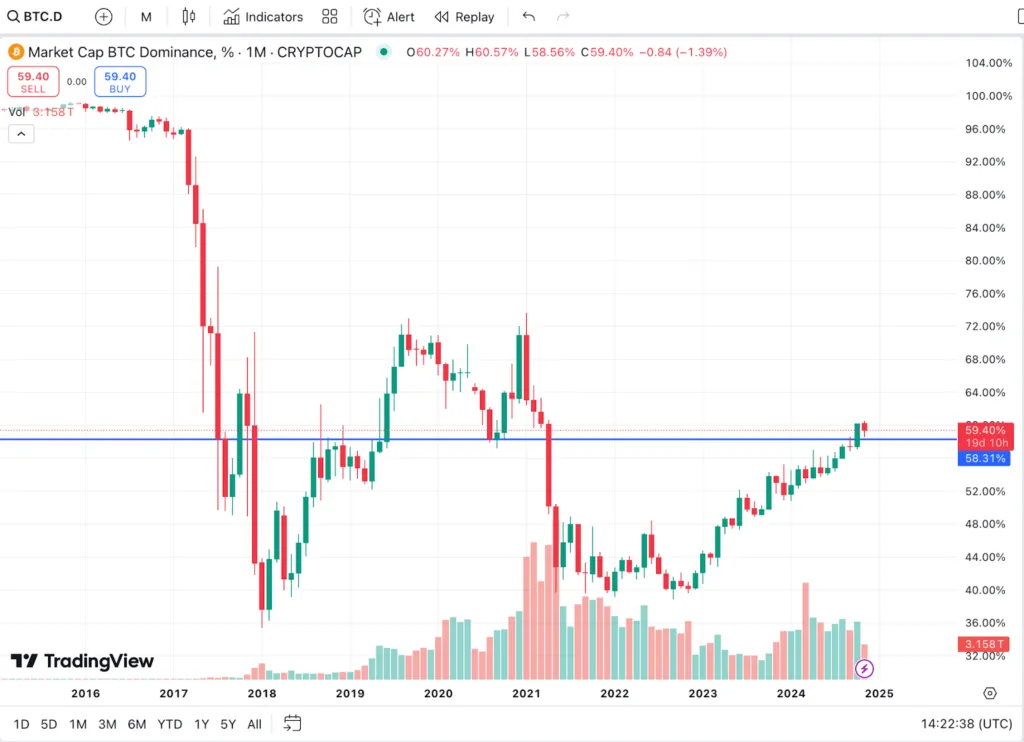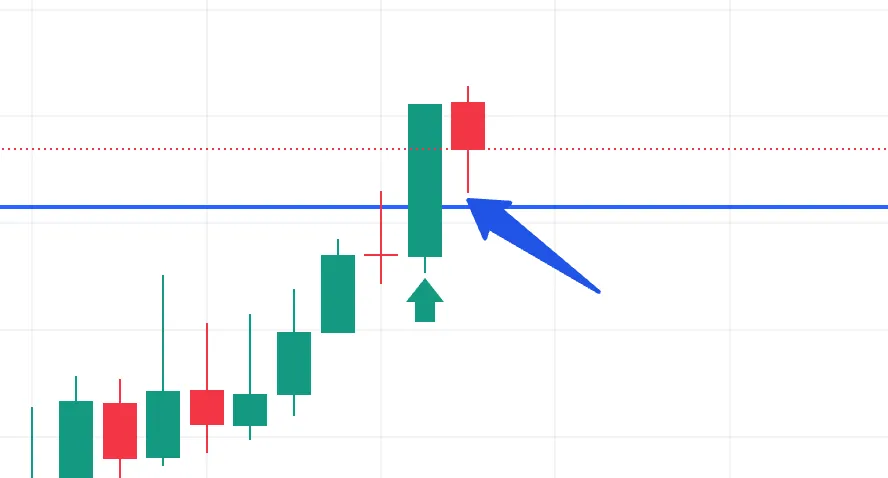|
Getting your Trinity Audio player ready...
|
In the world of investing, the age-old adage “The trend is your friend” is as relevant as ever. Recognizing a strong trend and understanding how to capitalize on it can be the difference between sitting on the sidelines and making meaningful gains. While I firmly believe that BSV will ultimately take the lead as the most significant blockchain in the world, BTC’s market dominance is flashing bullish signals right now, and that should not be ignored for the rest of the year.
BTC is displaying a classic “Breakout, Retest” pattern, a reliable indicator of potential growth, and all signs suggest that it could outperform other assets in the short term.
For those unfamiliar, here’s a brief breakdown: a long-term trend line represents psychological resistance when BTC trades below it, marking where market sentiment prevents it from climbing higher. BTC/USD has been trending below this line since early 2021, with upward momentum building over the last 18 months.

Finally, BTC has broken through this resistance line, signaling a bullish reversal that could result in months of positive movement. If BTC holds above this line, it would signal a shift in liquidity flowing into BTC from other blockchain assets.

A major catalyst behind this move is Donald Trump’s return to the White House. As polarizing as his previous administration was, his re-election could bring policies likely to support American industries and energy production—a favorable environment for BTC miners. Trump’s focus on energy independence, deregulation, and incentivizing domestic production positions BTC miners well. There’s also the fact that he has overtly come out to state that he will be a “crypto friendly” President and specifically block the creation of an American central bank digital currency (CBDC), so the perception that his administration could favor the U.S. blockchain sector, particularly mining, has fueled optimism in the market, creating what may be a brief but significant opportunity for those looking to make portfolio adjustments. For those inclined toward portfolio management over ideology, taking a position in BTC could allow them to capture some of this momentum.
Yet, despite the bullish potential, there are grounds for cautious optimism. Trump’s history with regulation and lack of sophistication in the blockchain industry may bring unintended consequences, as he could inadvertently bolster some of the less reputable aspects of the economy—like the constant pumper Charles Hoskinson.
My reservations lie here: Trump’s enthusiasm may amplify the hype around “crypto” at the expense of substantive blockchain development, reinforcing the more speculative—and typically fraudulent—underbelly of the industry. While BTC’s rally may appeal to investors’ desire for quick returns, the lack of nuance in Trump’s approach could inadvertently feed the volatility and exploitative tactics that plague these parts of this ecosystem.
Nonetheless, for those wary of betting on BTC, Trump’s re-election could spark growth in several other sectors for the savvy investor to consider:
– Energy and Fossil Fuels: The U.S. has been advancing toward energy independence for over a decade, with domestic petroleum products now being net exported globally. Trump’s policies could amplify U.S. oil and gas production, making traditional energy stocks attractive. His potential rollback of green energy mandates might also redirect investment flows toward traditional energy, affecting the valuations of stocks focused on renewables. Traditional energy producers may benefit as regulations ease and production ramps up.
– Defense and Security: With Trump’s emphasis on bolstering the military and securing borders, defense contractors may find new opportunities. Trump has peace-makers rhetoric internationally, seeing a potential end to globalist militarism, but cybersecurity firms, especially those involved in safeguarding critical information networks, are likely to benefit as “wars” increasingly shift the defense budget from ammunition to information on the digital battlefield. Companies within this sector may see substantial government contracts under a second Trump term.
– Manufacturing and Industrials: Trump’s focus on American manufacturing and import tariffs could boost domestic production. Industries ranging from steel to construction could benefit as policies encourage localized manufacturing. This trend may also extend extra deeply to medical equipment manufacturing, as the aging American population increases demand for domestically produced medical supplies and technology.
– Agriculture: Trump’s historical support for rural America and agricultural subsidies may lead to a favorable environment for American farmers. He could incentivize agribusinesses through subsidies or tariffs on imported food, effectively bolstering domestic agriculture. States like Ohio and Pennsylvania, instrumental in Trump’s past victories, may also receive further support, and with an eye on 2028, he could be grooming allies like J.D. Vance for future leadership, making agriculture a strategic focus.
This is in contrast to what might be rough years on the horizon for big pharma and their allies in the government as Robert Kennedy Jr. targets them for justice around various malfeasances over the last couple of decades, so smart money might be moving away from some of the best investments of the Biden administration.
While BSV’s potential remains the foundation of my outlook on blockchain, there are always opportunities to consider along the way. The ability to recognize and strategically ride a trend—especially when it aligns with broader economic and political shifts—can be a powerful tool for building wealth. A trend that is also starting to materialize seriously is the trend toward the popularity of independent political power—as this election clearly shows.
Political and cultural trend
And that’s another aspect of all of this that I really think is worth considering deeply. There is a new and encouraging macro trend in the culture.
Donald Trump’s political trajectory has been as maverick as they come, a fact that continues to influence his appeal. Trump was once a registered Democrat and a longtime ally to New York politics and families like the Clintons. His history mirrors those of many of his notable allies and backers: a strong business focus and a commitment to the American worker. Unlike the typical partisan playbook, Trump’s policies and rhetoric have drawn a significant populist coalition of disillusioned Democrats, moderates, and former liberals who have grown frustrated with what they see as an increasingly ideologically driven and divisive landscape on the left. This even crept into traditional minority communities who voted for Obama and Biden, but feel like the Democratic party has abandoned the middle class in favor of Hollywood and fringe social politics.
Figures like Elon Musk, Tulsi Gabbard, Robert F. Kennedy Jr., and even semi-outside allies like Joe Rogan are either directly aligned with Trump’s views or have found common ground with his emphasis on economic pragmatism, classical patriotism, and disdain for the “woke” culture that dominates mainstream Democratic politics today while still seeing themselves fundamentally as Democrats or liberals at their core.
Each of these figures once belonged to or aligned with the Democratic Party yet found themselves pushed out as their focus on practical issues like job creation, economic self-sufficiency, and freedom of speech became politically untenable in their former circles. Elon Musk, formerly a proponent of clean energy and tech-forward liberal policies, is now a vocal critic of identity politics, aligning more closely with libertarian and conservative values around business freedom and free speech. He’s also aligning himself with the classic maverick Republican Ron Paul to run “DOGE,” the Department of Government Efficiency.
Tulsi Gabbard, a former Democratic congresswoman and presidential candidate, left the party to focus on military reform, protection of individual liberties, and a non-interventionist foreign policy—issues she argues no longer have a place in the modern Democratic platform. Robert F. Kennedy Jr., a well-known pro-environmental and anti-corporatism advocate, has pivoted toward defending American freedoms against governmental overreach and the deep corporatism that has come on the backs of Democratic Party administrations, a position that has now made him a darling with unconventional, populist conservatives.
On an even more surprising note, we are even seeing health-conscious policies—a cornerstone issue of the populist left since at least the 1960’s—become a key right-wing issue as traditional conservatives embrace healthy eating and living as a core value. And the weird part is that liberals are now rejecting health due to its association with right-wing red flags!
In many ways, Trump’s upcoming administration appears ready to lead a coalition that is as untraditional as he is. This unorthodox crew’s appeal lies not in the traditional left-right spectrum but in their shared mission to cut through political ideology and focus on policies that have tangible effects on the lives of working Americans. They’re not afraid to ruffle feathers in either party, which resonates in an era where the electorate is deeply frustrated with the establishment. For the blockchain world, this new-school energy translates to a more favorable regulatory environment, particularly if policies are shaped with a hands-off, business-friendly approach, which will be a net good for the industry.
While Trump’s deeply unconventional style comes with risks—including his often unpredictable stance on regulation and the potential for bolstering the more speculative side of crypto—this new political climate presents a unique moment for growth-oriented sectors like mining, traditional energy, and blockchain. Each of these industries stands to benefit if Trump’s administration carries forward a pro-business, anti-regulation stance.
With all of this in mind, a savvy investor will keep an eye on the sectors that stand to benefit from Trump’s neo-traditional coalition, from BTC mining to fossil fuels, manufacturing, free speech media, and beyond. It might be a good season to follow the trend of entrepreneurship, health, personal empowerment, hard work, and, in some cases, just being an average American without any hyphens or reservations. Staying attuned to these trends could be the key to navigating the next four years of American politics with confidence and profitability.
On a personal note, there is a real opportunity here to ingratiate the new administration to the power of managing real assets on a truly scalable blockchain. Instead of simply criticizing Charles Hoskinson or Trump’s DeFi project, I would like to formally offer to explain Teranode, overlay networks, real-world assets, and the power of the Metanet concept for making the world a truly better place for commerce and free people around the world.
If you have a connection, hook me up!
Watch: Teranode is the digital backbone of Bitcoin

 07-04-2025
07-04-2025 





